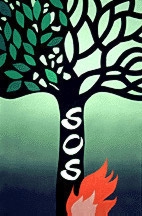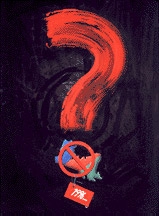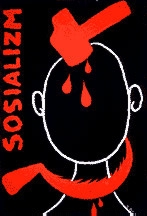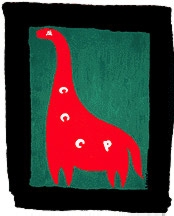|

Autumn 1996 (4.3)
Page 50
Azerbaijan Today
The Way
Graphic Artists See It
by Shaig Safarov
SOS: by Etibar Nazarov.
All others by Hashim Elichiyev. Question mark symbolizes unknown
future status of Nagorno-Karabakh; CCCP in Russian means USSR,
symbolizing that the Soviet Union has become a relic of past.
For the past three years, Unocal Khazar has sponsored a poster
contest, entitled "Azerbaijan Today," which provides
a creative forum for Azeri artists and enthusiasts. Each year,
on the eve of May 28, Azerbaijan's National Independence Day,
a crowd gathers at the Baku Arts Center on Injesenet Street (Street
of Arts) to view the year's portrayal of contemporary life as
seen through the eyes of Azerbaijani graphic artists.
These annual exhibitions are becoming a barometer of the society's
aspirations. As time passes, the posters seem to indicate that
Azerbaijanis are much more optimistic than earlier on after the
collapse of the USSR.
For example, one of the posters
in 1994 depicted a small, torn umbrella opened over a map of
Azerbaijan, symbolizing the collapse of Soviet protection and
the country's vulnerability during the first years of independence.
In 1996, another poster used the umbrella theme, this time depicting
the bright-colored flags of the countries of the AIOC Consortium,
showing the hope that oil will bring economic prosperity.
The 1996 Judging Committee, headed by Omar Eldarov, People's
Artist of Azerbaijan and the newly-elected President of Baku
Arts Center, awarded first place to Hashim Elchiyev. His poster
commemorated Vagif Mustafazade, the late jazz pianist and composer
who brilliantly synthesized Azerbaijani traditional mugam with
American swing. Mustafazade is revered in Azerbaijan not only
for his dynamic playing, but for his free spirit despite persecutions
during the Soviet era. Now, it seems particularly appropriate
that his daughter, Aziza Mustafa Zadeh, carries on his remarkable
tradition, as a brilliant jazz musician and performer in her
own right.
This year's second place winner, Aydin Ismayilov, depicted an
old fragment of Gobustan rock with its characteristic petroglyphs.
Gobustan is an early settlement not far from Baku with dozens
of rock carvings that date back more than 5,000 years. A sign
on the poster reads "For Sale" and urges the protection
of Azerbaijan's cultural memorials and national treasures. Increasingly,
Azeris are concerned that the privatization of land and buildings,
along with the new industrialization fueled by foreign investments
could threaten archeological sites of cultural importance. This
poster pleads for balance between economic development and cultural
and historic preservation.
The third award went to Ismayil Mammadov for his compilation
of posters announcing the AIOC / SOCAR sponsored concerts. This
monthly series, which is offered free to the public, has breathed
life into the musical activity in Baku and resurrected the philanthropic
tradition of Baku Oil Barons of the beginning of the century.
Over the years, the posters
have reflected some of the most crucial moments of the socio-political
life in the newly independent Republic. The art works have since
taken on a life of their own, appearing in magazines and newspapers,
and helping generate a new set of symbols. Unocal Khazar plans
to continue promoting this annual event which reflects the transitions
unfolding in Azerbaijan.
From Azerbaijan
International
(4.3) Autumn 1996.
© Azerbaijan International 1996. All rights reserved.
Back to Index
AI 4.3 (Autumn 1996)
AI Home
| Magazine
Choice
| Topics
| Store
| Contact
us
|




